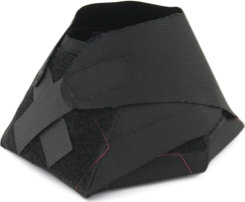About those two things, rattlesnakes and horses - they don't go along well together, now do they? I usually write an article, coming Spring, about the dangers of Rattlesnakes for when you are horseback or for your horses in general. This is the time the weather's warming up and Rattlesnakes are pretty active, leaving their dens to hunt as they have been dormant for several months. When warm weather is here to stay, Rattlesnakes will leave their dens traveling several miles to hunt and mate.
For most of the late Spring and Summer, it is rare for me to see a Rattlesnake unless it's in the early morning or evening, as during the hottest parts of the day they will tend to lay dormant out of the direct Sun. During the out of peak hot days, you'll sometimes see Rattlesnakes laying out in the open, such as on a trail, sunning themselves and soaking up the heat of the Sun.
An the late Summer - early Fall, depending upon the temperatures, is another dangerous time of year. The weather is cooling, promoting Rattlesnakes to be more active so they can hunt and get ready for hibernation. It's that time of year now, so be careful when you ride out.
I'm told that some Rattlesnakes don't den up for the winter, but most do. While I have encountered Rattlesnakes in the winter here in the Desert Southwest, all of those were likely disturbed from their winter dens.
If you have ever seen a Rattlesnake in the natural environment, you probably remarked that it was hard to se because of his color and pattern blending in with the environment. And you can't rely on the Rattlesnake warning you with this namesake rattling of his tail.
Many snakes won't rattle even when they become aware of your presence. I have heard some theories that believe Rattlesnakes have learned not to rattle as that attracts more attention from potential predators, namely human. Many Rattlesnakes bites come without the victim being warning and there can be a wide array on post bite damage depending upon how much venom was injected by the bite.
Best to not be bit in the first place. That's takes being aware. You are counting on your horse taking you somewhere and back, and your Horse is counting on your to keep him out of trouble. I have seen a wide range of awareness or response, or a lack of either, from horses when encountering snakes. As you know horses are generally curious. Something fairly small and moving can attract their attention. They drop their head, then wham! they get bite on the nose.
My wife and I were riding several days ago. She and her horse almost walked right on a stretched out Prairie Rattler. The snake did not rattle nor coil. My wife backed away and I positioned up on my horse to shoot it as this is my habit if Rattlesnakes are close to population (we were about 1/4 mile from a house, children and animals). Then the snake turned and started moving into some heavy brush right on the trail. I shot it in the body as that was the only shot I had, then as the snake curled up where I got a shot at his head.
If you end up killing a Rattlesnake or coming upon what you think to be a dead one, be careful as the head can still function and bite for an hour or maybe longer after the snake is for all practical purposes dead.
So as the weather gets cooling and your rides get longer just be a little more careful as Rattlesnakes are more active and you may not get the warning rattle.





















A story like this...us "gun guys" want to know what you used to dispatch the snake?
ReplyDeleteDan